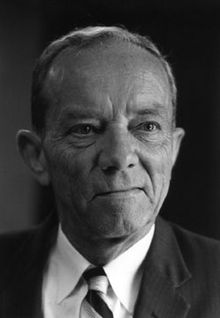Foy David Kohler(February 15, 1908 – December 23, 1990) was an American diplomat who was theUnited States Ambassador to the Soviet Unionduring theCuban Missile Crisis.
Foy D. Kohler | |
|---|---|
 | |
| 11thUnited States Ambassador tothe Soviet Union | |
| In office September 27, 1962 – November 14, 1966 | |
| President | John F. Kennedy Lyndon B. Johnson |
| Preceded by | Llewellyn Thompson |
| Succeeded by | Llewellyn Thompson |
| 5thAssistant Secretary of State for European Affairs | |
| In office December 11, 1959 – August 19, 1962 | |
| President | Dwight D. Eisenhower John F. Kennedy |
| Preceded by | Livingston T. Merchant |
| Succeeded by | William R. Tyler |
| Personal details | |
| Born | February 15, 1908 Oakwood,Ohio |
| Died | December 23, 1990(aged 82) Jupiter,Florida |
| Spouse | Phyllis Penn |
| Profession | Diplomat |
Early life
editKohler was born inOakwood, Ohiobut the family moved toToledowhen he was young. He attended theUniversity of ToledoandOhio State University,where he graduated in 1931 with a BS in foreign studies.[1]
He entered theForeign Serviceand served inWindsor (Canada),Belgrade (Yugoslavia),andBucharest (Romania).He married Phyllis Penn ofGreensboro, North Carolinain Bucharest in 1935.[1]Later they served inAthens (Greece),Cairo (Egypt),Vietnam,andBolivia.[2]
At the end of World War II, Kohler served as the assistant chief of the Foreign Service's Division of Near Eastern Affairs.[3]
Kohler studied Russian atCornell Universityin 1946 and then had his first tour inMoscowfrom 1947-49 working for AmbassadorWalter Bedell Smith.[1]
Ambassador to the Soviet Union
editFollowing a tour as Director ofVoice of America,in September 1962 PresidentJohn F. Kennedynamed Kohler Ambassador to theSoviet Union.He and his wife moved toSpaso House,the U.S. Ambassador’s residence in Moscow, and began a complete remodeling of the mansion.[1]
In just a few weeks theCuban Missile Crisisbegan and Kohler found himself engaged in defusing a serious international crisis. The Americans had found that the Soviets were placing nuclear missiles in Cuba. Soviet PremierNikita Khrushchevwas not well acquainted with Kohler, and what little Khrushchev did know about him he disliked. As a result, there was little that Kohler could have done to influence Khrushchev one way or another. Even so, Kohler proved useful by efficiently transmitting important messages between the White House and the Kremlin.[3]After two weeks of tension over the risk of escalation, Khrushchev agreed to remove the missiles.
The experience convinced both sides of the need for better communications. On June 20, 1963, the two countries agreed to set up a continuous connection over a secure transatlantic cable, as a "hot line"for use in times of emergency.[4][5]
On August 5, 1963, theLimited Test Ban Treaty,which banned nuclear testing in the atmosphere, under water, or outer space, was signed in Moscow.[6]This was to be the first in a series of arms control agreements between the superpowers.
On March 6, 1967, Kohler received word thatSvetlana Alliluyeva,the daughter of former Soviet leaderJoseph Stalinhad decided to defect to the U.S. inNew Delhi.He had the responsibility to inform the Soviets via their Ambassador to the U.S.,Anatoly Dobrynin.[1]
Kohler retired from the foreign service in 1967 with the personal rank of Career Ambassador.
After government service
editThe Kohlers moved toFloridaand he became a professor of international studies at the Center for Advanced International Studies of theUniversity of Miami.
He died December 23, 1990. He and Phyllis never had children. He was a member of theCouncil on Foreign Relations,Beta Gamma Sigma,Delta Upsilon,andPhi Beta Kappa.[1]
Works
editArticles
edit- "The Effectiveness of the Voice of America."Quarterly of Film Radio and Television,vol. 6, no. 1 (Autumn 1951), pp. 20–29.JSTOR1209931.doi:10.2307/1209931.
- "The International Significance of the Lunar Landing,"with Dodd L. Harvey.Journal of Interamerican Studies and World Affairs,vol. 12, no. 1 (Jan. 1970), pp. 3–30.JSTOR174840.doi:10.2307/174840.
Notes
edit- ^abcdefKohart, Georgia,Foy David Kohler ObituaryArchived2012-02-08 at theWayback MachineDefiance Ohio Crescent-News January 28, 2001
- ^U.S. Ministers and Ambassadors to RussiaArchivedOctober 6, 2007, at theWayback Machine,American Embassy, Moscow
- ^abMayers, David (1995).The Ambassadors and America's Soviet Policy.New York and Oxford: Oxford University Press. p. 213.ISBN0195115767.
- ^U.S. State Department."Hot Line Agreement (1963)".Atomic Archive. Archived fromthe originalon August 30, 2022.RetrievedAugust 30,2022.
- ^Stone, Webster (September 18, 1988)."Moscow's Still Holding".New York Times.Archivedfrom the original on June 30, 2015.RetrievedOctober 28,2014.
- ^Limited Test Ban Treaty (1963)